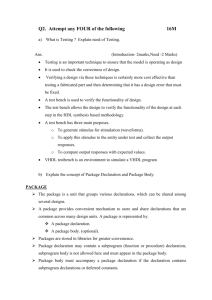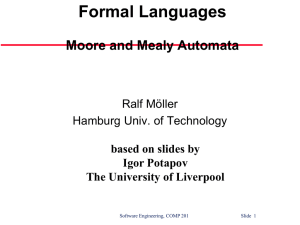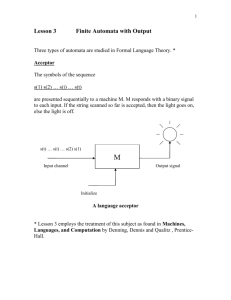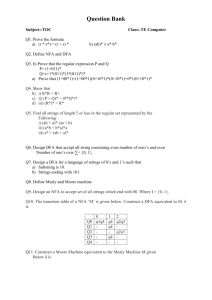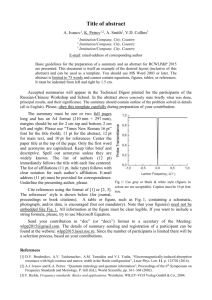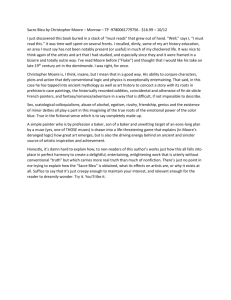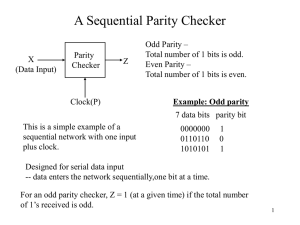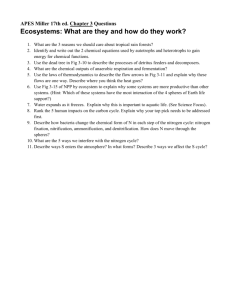Chapter text
advertisement
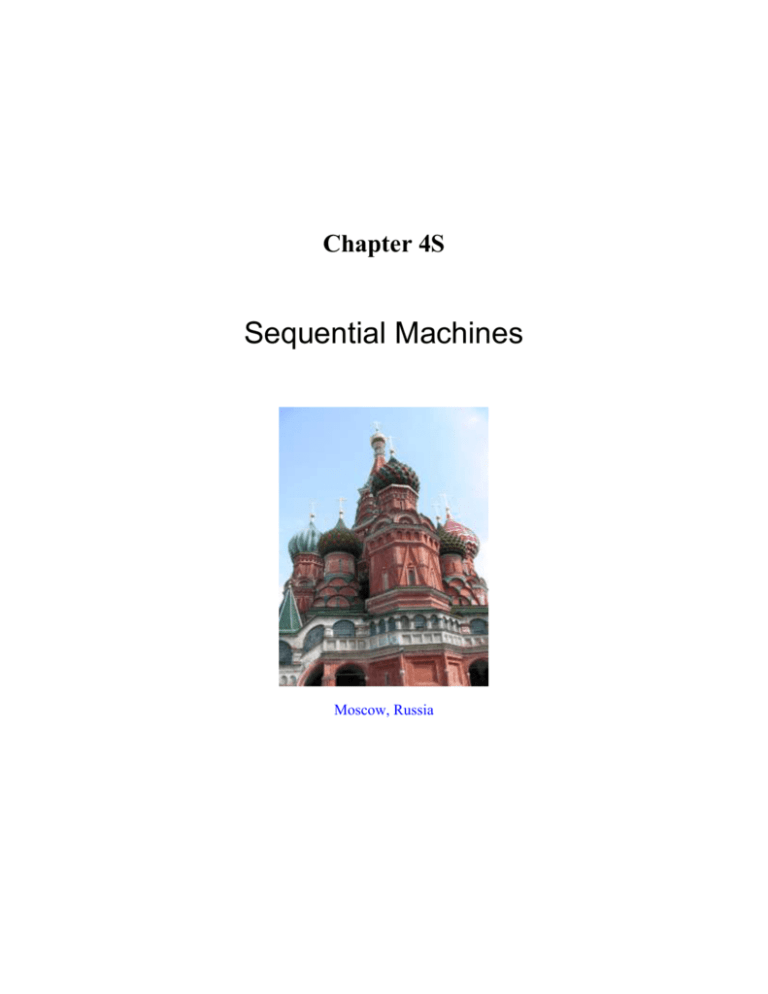
Chapter 4S
Sequential Machines
Moscow, Russia
Outline
4.1 Basic Concepts of Sequential Machine
4.2 Definition of Sequential Machine
4.3 Implementation of Finite Automata by Sequential Machines
4.4 Construction of Deterministic Finite automata by Digital Circuits
4.5 Equivalence of Mealy Machine and Moore Machine
4.6 Simplification of Sequential Machines
2
4s.1 Basic Concepts of Sequential Machine
Concepts -- Each FA accepts inputs but yields no output, or we can say, yields the simple outputs of
“accept” or “reject.”
Many application systems have both inputs and outputs, like digital systems, computers,
compilers, etc.
We need automata with capabilities of not only accepting inputs but also yielding
outputs --- sequential machines!
Basic properties of sequential machines -- The sequential machine may be regarded as an extension of the deterministic finite
automaton.
The name “sequential machine” comes from its nature of changing its output and state
“in a timely order,” or equivalently, “sequentially,” according to the input and the
current state.
The sequential machine is defined to have no final state.
The sequential machine has many applications for systems with outputs, like modeling
vending machines, elevators, traffic signals, etc.
Abbreviation of a term --- in the sequel, we abbreviate “sequential machine” as “SM.”
4s.2 Definition of Sequential Machine
Types of sequential machine --There are two types of SM --- Mealy machine and Moore machine, which were
developed from the study of digital systems.
Fig. 4s.1 shows the Mealy machine model whose output depends on both the input and
the current state of the machine.
Fig. 4s.2 shows the Moore machine model whose output depends only on the current
state of the machine.
Input x
combinational
circuit
output y
current
Next
state
state
storage
Fig. 4s.1 Mealy machine model.
Example 4s.1 (a serial adder – a Mealy machine) --Fig. 4s.3 is a serial adder commonly seen in digital systems, which adds
sequentially three 1-bit inputs (the addend x, augend y, and the old carry c) and yields
two 1-bit outputs (the sum z and the new carry c').
3
For example, in the series addition result 0011 + 1001 = 1100 with carries 0011, the
serial adder adds up initially x = 0, y = 1, c = 0 (the initial value if the flipflop) to get z
= 1, c' = 0.
The serial adder obviously can be checked to be a Mealy machine because comparing
with Fig. 4s.1, we have
the full adder = the combinatorial circuit in Fig. 4s.1;
the D-type flipflop = the storage in Fig. 4s.1;
the addend x, the augend y, and the old carry c = the input;
the sum z and the new carry c' = the output;
the new carry c' and the pulse signal s (for triggering the flipflop) = the next state;
the old carry c = the current state.
input x
current
combinational
circuit A
storage
next
state
state
combinational
circuit B
output y
Fig. 4s.2 Moore machine model.
addend x
(input)
sum z
full adder
augend y
(output)
new carry c'
old carry c
(next state)
(current state)
Q
Q
D flipflop
Q
pulse signal
Fig. 4s.3 Full adder --- a Mealy machine --- of Example 4s.1.
Example 4s.2 (a 2-bit binary counter with outputs - a Moore machine) --Fig. 4s.4 is a 2-bit binary counter, which counts binary numbers 00, 01, 10, 11 in
sequence and cyclically in accordance with the input pulse signals.
The counter has a 1-bit output of 1 when the count comes to the number 00, so that it
has an output sequence of the form 00010001… if the input pulse signal continues for a
long time.
The binary counter can be checked to be a Moore machine because comparing with Fig.
4s.2, we have
the two D-type flipflops = the storage in Fig. 4s.2;
the circuit to the right of the two flipflops = combinational circuit A in Fig. 4s.2;
4
the circuit to the left of the two flipflops = combinatorial circuit B in Fig. 4s.2;
the output y only depends only on the state of the two flipflops.
Q
D-type flipflop
Q
input x
Pulse signal
Q
D-type flipflop
Q
output y
Fig. 4s.4 Binary counter --- a Moore machine --- of Example 4s.2.
Definition 4s.1 (Mealy machine) --A Mealy machine M is a 6-tuple M = (Q, , , , , q0), where
1. Q , , and q0 are the same as defined for the DFA;
2. is a finite, non-empty output alphabet;
3.
is an output function such that : Q , i.e., for any q Q and any a ,
(q, a) = b where b .
Definition 4s.2 (Moore machine) --A Moore machine M is a 6-tuple M = (Q, , , , , q0), where all elements are the
same as those defined for the Mealy machine except that : Q (instead of : Q
), i.e., for any q Q,(q) = b where b .
Discussions on the definitions -- Determinism of SM’s ---
The types of SM’s are both deterministic in nature as defined.
Difference between the two types of SM’s ---
The output of the Mealy machine depends on the current state and the input while
that of the Moore machine depends only on the current state.
But this difference does not cause any difference on the capabilities of the two
types and this will be proven later in this chapter.
The output of the Mealy machine ---
Given an input string x = a1a2…an, the output of the Mealy machine is another
string of the form (q0, a1)(q1, a2)…(qn-1, an), where q1, q2, …, qn-1 result from a
series of state transitions `(qi-1, ai) = qi starting from the initial state q0, where i = 1,
5
2, ….
We use (x) to represent the output string (q0, a1)(q1, a2)…(qn-1, an).
The output of the Moore machine ---
Given the input string x = a1a2…an, the output of the Moore machine is another
string (q0)(q1)…(qn-1), where q1, q2, …, qn-1 are generated in the same way as the
Mealy machine does.
Similarly, we use (x) to represent the output string (q0)(q1)…(qn-1).
Response of the Moore machine to the initial state ---
Because the Moore machine yields an output in accordance with the current state
only, it has an output in the initial state, which is just (q0) .
This may be regarded as an output (q0) for the input of the empty string .
Response of the Mealy machine to the initial state ---
As a contrast to the former case, the Mealy machine does not yield an output in its
initial state because only when there is an input can the Mealy machine has an output.
Therefore, we may say that for the input of the empty string , the Mealy machine
yields the output of the empty string without changing the state. This corresponds
to the case that the extended DFA has the transition (q0, ) = q0.
Final state of the SM ---
The SM yields an output symbol each time an input symbol is supplied; no final
state is involved in this process.
A graphic model for the SM ---
A graphic model for the SM is shown in Fig. 4s.5, which is the same as that for the
DFA except that there is an additional tape on which the output string of symbols are
written with a writing head.
Descriptions of the SM ---
Like the DFA, the state transition function and the output function of an SM can be
described by an exhaustive description, a state transition diagram, or a state transition
table which includes additionally mappings to the outputs, as shown by the following
two examples.
input tape 0 1 1 0 1 0
Reading head
…
finite
control
Writing head
output tape a
a b b
Fig. 4s.5 A graphic model for the sequential machine.
6
…
Example 4s.3 (descriptions of a Mealy machine – the full adder) --The various descriptions of the full adder, which is a Mealy machine M as mentioned
in Example 4s.1, are given in the following:
M = (Q, , , , , q 0 )
where
Q = {0, 1}(the 1-bit carry c kept in the D-type flipflop represents the state of the
machine);
= {00, 01, 10, 11}(the bit pair consisting of the values x and y of the addend and
augend, respectively, is the input);
= {0, 1}(the sum z is the output);
: Q Q, or more specifically, : (c, xy) c' where c' is the carry computed by
use of the full adder;
: Q , or more specifically, : (c, xy) z;
q0 is the initial binary value kept in the D-type flipflop, which is assumed to be 0;
and are described by three ways as follows.
Exhaustive listing --(0, 00) = 0;
(0, 01) = 0;
(0, 10) = 0;
(0, 11) = 1;
(1, 00) = 0;
(1, 01) = 1;
(1, 10) = 1;
(1, 11) = 1;
(0, 00) = 0;
(0, 01) = 1;
(0, 10) = 1;
(0, 11) = 0;
(1, 00) = 1;
(1, 01) = 0;
(1, 10) = 0;
(1, 11) = 1.
e.g., (1, 01) = 1 represents the binary addition c + (x + y) = 1 + (0 + 1) = 10 which
means a sum z = 0 and a new carry c' = 0.
Transition diagram --- as shown in Fig. 4s.6 where the notation xy/z beside each
arrow means that with the input xy, the machine yields the output z.
00/0, 01/1, 10/1
01/0, 10/0, 11/1
11/0
start
開始
0
1
00/1
Fig. 4s.6 Transition diagram of the Mealy machine --- a full adder --- of Example 4s.3.
圖 9.6 例 9.3 系列式加法器的轉變圖。
Transition table --- as shown in Table 4s.1 where the notation c'/z in each entry
means that the machine gets into the new state c' and yields the output z.
Example 4s.4 (descriptions of a Moore machine – the binary counter) --The various descriptions of the binary counter of Example 4s.2, which is a Moore
machine M, are given in the following:
7
Table 4s.1 Transition table of Example 4s.3.
input
00
01
10
11
0
0/0
0/1
0/1
1/0
1
0/1
1/0
1/0
1/1
state
M = (Q, , , , , q 0 )
where
Q = {00, 01, 10, 11}(the bit pair uv kept in the two flipflops represents the state of the
machine);
= {0, 1}(input x = 0 means stopping counting; input x = 1 means beginning
counting);
= {0, 1}(output y = 0 means the count value of 1, 2, or 3; output y = 1 means the
count value of 0);
: Q Q, or more specifically, : (uv, x) u'v' where bit pair u'v' represent the
new state;
: Q or more specifically, : uv y;
q0 specifies the initial bit pair kept in the two flipflops, assumed to be 00;
and are described by two ways as follows (the exhaustive listing is omitted).
Transition diagram --- as shown in Fig. 4s.7 where the notation uv/y inside each state
circle means that the machine in state uv yields the output y.
Transition table --- as shown in Table 4s.2 where the notation uv/y in each entry of
the first column means the same as that used in the transition diagram.
0
start
開始
0
1
01/0
00/1
1
1
1
11/0
10/0
0
0
Fig. 4s.7 Transition diagram of the Moore machine --- a binary counter --- of Example 4s.4.
圖 9.8 例 9.4 中計數器的轉變圖。
8
Table 4s.2 Transition table of Example 4s.4.
input
0
1
00/1
00
01
01/0
01
10
10/0
10
11
11/0
11
00
Current state/output
State transition tables used in digital systems --For digital systems, automata are described by transition tables of another form which
has the merit that there is no difference between the table for the Mealy machine and that
for the Moore machine. We call such transition tables to be of the digital system style.
The digital-system-style transition table for the fuller adder of Example 4s.3 is shown
in Table 4s.3 and that for the binary counter of Example 4s.4 is shown in Table 4s.4.
Table 4s.3 The transition table of the digital system style of Example 4s.3.
Current
Input
Next
Output
state
x
state
y
0
00
0
0
0
01
0
1
0
10
0
1
0
11
1
0
1
00
0
1
1
01
1
0
1
10
1
0
1
11
1
1
Table 4s.4 The transition table of the digital system style of Example 4s.4.
Current
Input
Next
Output
state
x
state
y
00
0
00
1
00
1
01
1
01
0
01
0
01
1
10
0
10
0
10
0
10
1
11
0
11
0
11
0
11
1
00
0
9
Example 4s.5 --Redesign of the vending machine described in Chapter 0 with a Mealy machine.
In Chapter 0, we have used a DFA to design a drink-selling vending machine with no
output which is not realistic because a real vending machine does have outputs, the sold
drinks.
Here the machine will be remodeled by an SM, or more specifically, by a Mealy
machine.
The DFA in Chapter 0 is redrawn here as Fig. 4s.8with:
all the dollar signs in the diagram being removed,
the notation $i of each state being changed into <i> for clarity, and
the two transitions from state 15 to state 20 being combined into one (represented
with only one arrow now).
The machine only sells 20-dollar goods with 5- and 10-dollar coins as inputs; and it has
several types of outputs:
coins other than 5 and 10 dollars which are not accepted by the machine, as assumed,
to simplify the design;
the excessive amount of money which will be returned when more than 20 dollars are
put into the machine slot;
the drink dropped out which the user choose to buy by pushing a “buy button”;
no response from the machine which the input money is not sufficient to buy a drink.
5
start
10
<0>
<15>
<5>
5
5
10
<10>
5, 10
10
<20>
Fig. 4s.8 The vending machine modeled by an DFA (a repetition of Fig. 1.2).
The desired Mealy machine is described as follows:
M = (Q, , , , , q 0 ),
where
1. Q = {0, 5, 10, 15, 20} in units of dollar;
2. input alphabet = {5, 10, b} with
“5” and “10” representing respectively 5- and 10-dollar coins, and
“b” representing pushing the “buy button”;
3. output alphabet = {, 5, 10, f} with
representing “no response” from the vending machine;
“5” and “10” representing the returned coin changes; and
f representing the drink dropped out of the machine;
10
4. and are shown in Fig. 4s.9.
5. the initial state q0 = 0.
The differences between Fig. 4s.8 and Fig. 4s.9 include the following.
1. No final state is used now in the Mealy machine.
2. Pushing the “buy button” (i.e., with the input b) while the machine is in all states
other than <20> will cause the machine to emit an output of “no response”
without changing the state.
3. Putting money into the machine while it is in states other than <15> and <20>,
will cause the machine to change its state but with no output;
4. Putting 5 dollars into the machine will cause no output, and putting 10 dollars
into to the it will result in a return of 5 dollars; and for both cases the machine
will get into the state of <20>.”
5. In the state of <20>, all money put into the machine will be returned, and in that
state, a push of the buy button” will cause a drink to drop out and a return into
the initial state.
b/
b/
b/
5/
start
10/
0
15
5
10/
5/
5/
10
10/
5/, 10/5
20
5/5, 10/10
b/
b/f
Fig. 4s.9 The vending machine modeled by a Mealy machine.
4s.3 Implementation of Finite Automata by Sequential Machines
Concept -- Though a DFA has no output, it has the simple responses of “accept” and “reject” to
input strings.
If we regard these two types of responses as outputs, and use the output strings of “1”
and “0” to represent them respectively, then we can use the SM to implement a DFA.
Implementation of a DFA by an SM -- Let M = (Q, , , q0, F) be a given DFA, we can implement it by two ways using the
Mealy machine and the Moore machine.
Implementation by a Moore machine --M’ = (Q, , , , , q0)
11
where
= {0, 1}( with “1” representing “accept,” and “0” representing “reject”);
is defined as: for all q F, (q) = 1, and for all q F, (q) = 0 (i.e., if the machine
gets into a final state, it emits “1” as the output; otherwise, “0” as the output).
Pros and cons of using the Moore machine ---
Merit --- the machine, after getting into a final state (not during state transiting),
emits a “1” which emulates the function of the FA to accept the input string.
Disadvantage 1 --- the machine, whenever in a final state but with the input string not
read to the end, will emit a “1” to accept the string as well, which obviously is
incorrect as viewed from the definition of FA.
Disadvantage 2 --- furthermore, in the initial state q0, even when the first symbol of
the input string is not read yet, the machine has the first output of (q0) which is
incorrect, either, as viewed from the definition of FA again.
We will remove the above two disadvantages later.
Implementation by a Mealy machine:
M’ = (Q, , , , , q0)
where
= {0, 1}( with “1” representing “accept,” and “0” representing “reject”);
is defined as: for all p Q, and for all a , if (p, a) = q F, then (p, a) = 1;
otherwise, (p, a) = 0 (i.e., when a final state is reached from a state, the output “1” is
emitted during the state transition; otherwise, “0” is emitted).
Pros and cons of using the Mealy machine ---
Merit 1 --- the machine, while transiting into a final state, emits an “accept” signal
“1” as output, unlike the Moore machine above which emits the “accept” signal after
getting into the final state.
Merit 2 --- no output is emitted while in the initial state because the Mealy machine
emits output symbols during state transitions.
Disadvantage --- similar to Disadvantage 1 of the Moore machine above, i.e., the
machine, whenever transiting into a final state, will emit a “1” to accept the string
even if the input string is not read to the end (an incorrect action again as viewed
from the definition of FA).
Example 4s.6 --Implement the DFA given in Fig. 4s.10(a) by a Mealy machine and a Moore machine.
(Can you see what language the DFA accepts?)
Implementation by a Mealy machine ---
By the above discussions, we can transform the DFA into a Mealy machine as shown
in Fig. 4s.10(b).
But this Mealy machine has the above-mentioned disadvantage of entering the final
state with the emission of an “accept signal” of “1” before the input string is read to
its end.
For example, with the input x = baba, the output string will be y = 0101, in which the
first “1” is not what we want.
One way to remove this advantage is to append an additional special symbol <EOS>
12
(EOS means the end of a string), and redefine the output function to be: only when
the state of q2 is entered and the symbol <EOS> is read in can the output “1” be
emitted.
Accordingly, the new Mealy machine becomes that shown in Fig. 4s.10(c).
And then, with the new input string of x = baba<EOS>, the correct output y = 00001
will be emitted as can be checked.
Implementation by a Moore machine ---
If implementation of the DFA by a Moore machine is desired and the
above-mentioned disadvantage of entering the final state with the emission of an
“accept signal” of “1” before the input string is read to its end is to be avoided, then,
as can be figured out, it is needed to add an extra state q3 and redefine the state
transition function to have the following transition:
while in the state of q2, with input symbol <EOS>, the machine enters the state
q3 and emits an “accept” signal as output in that state.
A Moore machine with the above function is shown in Fig. 4s.10(d).
With the input string x = baba<EOS>, the output string will be y = 000001, in which
except the first “0” which is emitted while the machine is in the initial state, the
remaining part is all what we want.
It is noted that the above Moore machine in Fig. 4s.10(d) can be obtained directly
from transitioning Fig. 4s.10(c) according to a theorem to be given later.
b
a
b/0
a/1
a
start
q1
a/1
q2
start
b
q1
q2
b/0
(b)
(a)
b, < E O S >
b/0, <EOS>/0
a
a
a/0
start
<EOS>
a/0, <EOS>/1
q1
start
q2
q1/0
q2/0
b
<EOS>
q3/1
a
b/0
b
(c)
(d)
Fig. 4s.10 Transforming a DFA into an SM. (a) A given DFA. (b) A Mealy machine corresponding to (a). (c) A Mealy
machine resulting from modifying (b). (d) A Moore machine corresponding to (a).
A comparison of the Mealy machine and the Moore machine -- In the last example, we have seen the fact that with the same functions, the Moore
machine will use one more state than the Mealy machine.
13
In more general cases, this fact is also true, but not just using one additional state but
possibly more.
In short, compared with the Mealy machine, the Moore machine has a simpler output
function but uses more states to solve the same problem.
4s.4 Construction of Deterministic Finite automata by Digital Circuits
Concepts -- The SM was originally developed in the study of digital systems, as mentioned before.
Therefore, as long as a DFA is implemented by an SM, we can construct the SM with
digital circuits to realize the goal of hardware implementation.
This is really the greatest application of the study of finite automata.
Process of Constructing a DFA by a digital circuit -- In the general case, during the process of solving a digital circuit problem, the first
concept of the circuit system to be designed is usually based on an intuitive RE (regular
expression) or the -NFA (epsilon-nondeterministic finite automaton).
That is, usually the design process is based on the following steps (the arrows indicate
transformations or implementations):
concept RE -NFA -NFA DFA SM hardware.
The last step in the above process is the topic of this section.
Example 4s.7 --Design a digital circuit to implement the Moore machine of the last example shown in
Fig. 4s.10(d).
A note: when an input string is read by an SM, it is always assumed that the machine
begins to work from an initial state.
Modification before hardware implementation ---
When a digital system is started, the flipflops in the system will get into arbitrary
states, i.e., the values of the flipflops will be random.
To remedy this, it is desired to bring the machine from such an arbitrary state into a
specified real initial state.
One way to do this is to add a special symbol <SOS> to the input string as its prefix
(SOS means start of string), and then redefine the state transition function to include
a new transition: the machine, in any state, will get into the real initial state q1 as
long as the special symbol <SOS> is read as an input symbol.
Furthermore, so far three states are created for the Mealy machine which we desire.
Therefore, two flipflops are needed to keep the three states.
But then four states can be created by the use of the two flipflops, yielding a fourth
state into which the system might also get when the system is initiated.
Therefore, the transition function must also take care of this case, i.e., the transition
(q4, <SOS>) = q1 must be defined as well.
14
According to the above discussions, we now can transform Fig. 4s.10(d) into a
transition diagram as shown in Fig. 4s.11.
a, b, <EOS>
q4/0
<SOS>
a
b, <EOS>, <SOS>
start
開始
q1/0
a
<EOS>
<EOS>
q2/0
q3/1
a
b, <SOS>
b, <SOS>
Fig. 4s.11 A new Moore machine resulting from modifying Fig. 4s.10 before being implemented by a digital circuit.
Further modification to simplify hardware circuit complexity ---
Fig. 4s.11 may be modified further to simplify the hardware circuit we are going to
design.
Specifically, at first we know that after reading an acceptable input string with
<EOS> as the last symbol, the machine will get into the state q3 and emit the accept
signal “1.”
Here, we may assume that after processing an input string x, the circuit system will
initiate again and get into a random state, followed by the reading of the first symbol
<SOS> of another string y to get into the initial state q1 for further processing of y.
Therefore, in the state of q3, we may assume that no more symbol will be read in by
the machine, i.e., a, b and <EOS> will not be the input symbols, so that the
transitions (q3, a), (q3, b) and (q3, <EOS>) become the so-called don’t-cares in
digital systems, i.e., these transitions may be assigned any arbitrary values which can
be utilized to simplify the hardware design.
Another case which can be utilized to simplify circuit design is: the state q4 can be
entered only during the system initialization process, and so we may assume that in
q4, only <SOS> can be read in; any other symbols a, b or <EOS> cannot.
Therefore, we may also let (q4, a), (q4, b) and (q4, <EOS>) as don’t cares for
circuit design simplification.
The process of digital circuit design is as follows.
Coding of input symbols --- there are four different symbols, a, b, <SOS> and
<EOS>; and there need two bits I1 and I2 to represent them as follows: I2I1 = 00 for
<SOS>, 01 for a, 10 for b, and 11 for <EOS>.
Coding of states --- there are four states q1 through q4; and there need as well two bits
D1 and D2 to represent them as follows: D2D1 = 00 for q4, 01 for q1, 10 for q2, 11 for
15
q3. Note that D1 and D2 are also used to specify the flipflops which save the two bit
values.
State transition table of the digital system style --- according to the codings above, we
may write down a transition table of the digital system style as shown in Table 4s.5,
in which the symbol is used to represent “don’t care.”
Table 4s.5 The transition table of the digital system style of Example 4s.7.
Current state
Input
x
Next state
Output
D2D1
I2I1
D2’D1’
y
00
00
00
00
01
01
01
01
10
10
10
10
11
11
11
11
00
01
10
11
00
01
10
11
00
01
10
11
00
01
10
11
01
01
10
01
01
01
10
01
11
01
0
0
0
0
0
0
0
0
0
0
0
0
1
1
1
1
Boolean expression for the circuit output equation --- from the transition table, we
can see that the output of the system depends only on the current state (which comes
from the original property of the Mealy machine). Specifically, we can figure out that
the Boolean equation for the output y is y = D2D1.
Boolean expression for the input equation of the next state D1' of flipflop D1 --- this
can be derived, by observation, from the Karnaugh map (constructed from the
transition table) of D1 as shown in Fig. 4s.12(a) to be D1’ = I 1 + I2 (note: in this
process, we have utilized the don’t cares marked as to simplify the resulting
expression).
Boolean expression for the input equation of the next state D2' of flipflop D2 --- this
can be derived from the Karnaugh map of D2 as shown in Fig. 4s.12(b) to be D2’ =
I 2 I1 + D2I1 = ( I 2 + D2)I1.
Digital circuit diagram --- the final digital circuit designed accordingly is shown in
Fig. 4s.13.
Check of the correctness of the designed circuit --- for input string x =
<SOS>baba<EOS> = (00)(10)(01)(10)(01)(11), we can check to circuit operation to
see the output y = 000001 which is correct, where “” in y is used to represent the
initial random output value of the system before the symbol <SOS> is read in, and
the last bit “1” means the input string is accepted.
16
I2
I2 I1
00 01
11
I2
10
I2 I1
D2D1
D1
00 01
11
10
00
0
x
x
x
01
0
1
0
0
11
0
x
x
x
10
0
1
1
0
D2D1
00
1
x
x
x
01
1
0
1
1
11
1
x
x
x
10
1
0
1
1
D1
D2
I1
D2
I1
(a)
(b)
Fig. 4s.12 Karnaugh maps for flipflops D1 and D2 of Example 4s.7. (a) Map for D1'. (b) Map for D2'.
D2’
I1
Q
型正反器 D2
DD-type
flipflop D2
D2
Q
(D flipflop)
輸入
Input
I1
I2
Output
輸出
y y
D1’
I2
型正反器 D1
DD-type
flipflop D
Q
D1
1
Q
(D flipflop)
脈衝信號
Pulse signal
圖 9.17 例 9.7 所設計之數位線路圖。
Fig. 4s.13 Designed circuit for Example 4s.7.
4s.5 Equivalence of Mealy Machine and Moore Machine
Concepts -- The Mealy machine and the Moore machine seem to be different in appearance, but
actually they can be proven to be equivalent, as will be done in this section.
This point in fact have been seen once in Section 4s.3 where we used a Mealy machine
and a Moore machine to implement a DFA.
It is also noted that with no input symbol, the Moore machine can emit an output
symbol while in the initial state.
Definition of equivalence of Mealy machine and Moore machine --Given a Mealy machine M1 and a Moore machine M2 with respective output functions
1 and 2, if for all input string x, the equality b1(x) = 2(x) holds where b is the output
of M2 in its initial state, then M1 and M2 are aid to be equivalent.
17
Note that the equivalence of two SM’s based on the equality about strings instead of
about languages because we have not defined the language accepted by the SM (Can
we do so? Think about it!).
Theorem 4s.1 (Constructing an equivalent Mealy machine from a given Moore
machine) --Given a Moore machine M1 = (Q, , , , , q0), there exists an equivalent Mealy
machine M2.
Proof.
At first, we construct a Mealy machine M2 = (Q, , , , ', q0), where ' is defined in
such a way that
“for all a and q Q, '(q, a) = ((q, a)).”
(A)
With the constructed Mealy machine above, check Fig. 4s.14 to see the relation
between ' and .
Now let b = (q0). Then, according to the definition of SM equivalence, what we have
to do is just to prove the following equality to be true for all x *:
b'(x) = (x).
(B)
For this, the proof technique of induction with respect to the length |x| of the input
string x is adopted as follows.
Basis -- When |x| = 0, i.e., when x = , the output of the Moore machine is (q0) as mentioned
before, so (x) = () = (q0) = b.
For the input x = which is nothing, the output of the Mealy machine is obviously
nothing as well by definition, i.e., '(q0, ) = therefore, '(x) = '() = .
Consequently, we have b'(x) = b = b = (x), i.e., for |x| = 0, the equality (B) holds.
Induction -- Now suppose that for |x| = k with x = a1a2…ak, the equality (B) is true, where k 0,
which means that the following equality holds:
b'(x) = (x),
(C)
and there is a state sequence q1, q2, …, qk such that (q0, a1) = q1, (q1, a2) = q2, …,
(qk-1, ak) = qk.
When y = xak+1 with |y| = k + 1, assume that (qk, ak+1) = qk+1.
Then, we have
(y) = (xak+1)
(
= (x)(qk+1)
= (x)((qk, ak+1))
= (x)'(qk, ak+1)
= b'(x)'(qk, ak+1)
= b'(xak+1)
= b'(y).
(by definition of (xak+1))
(
(qk, ak+1) = qk+1)
(by definition of ' in (A))
(according to (C))
(by definition of '(xak+1))
(
18
y = xak+1)
y = xak+1)
That is, for |y| = k + 1, (B) holds.
In conclusion, we have proved that for all possible x *, (B) holds. This completes
the proof of the theorem.
a
q/b
(a)
a/b’
q
q’/b’
(a)
給予穆爾機之一部份。
(b)
q’
(b)
對等密利機之一部份。
圖 9.18
由machine
穆爾機建
等 密machine.
利 機 。 (a) Part of given Moore machine.
Fig. 4s.14 Constructing an equivalent
Mealy
for構
a對
Moore
(b) Part of equivalent Mealy machine.
□
Example 4s.8 --Transform the Moore machine shown in Fig. 4s.10(d) into an equivalent Mealy
machine.
According to Theorem 4s.1, or more specifically, according to the way mentioned in (A)
above: “for all a and q Q, define '(q, a) = ((q, a)),” a Mealy machine M2
equivalent to the Moore machine M1 shown in Fig. 4s.10(d), which is repeated in Fig.
4s.15(a), is shown in Fig. 4s.15(b).
For example, the transition (q2, b) = q1 and the output (q1) = 0 of M1 leads to creation
of the output '(q2, b) = 0 of M2.
The Mealy machine shown in Fig. 4s.15 actually can be simplified to be that shown in
Fig. 4s.10(c).
Simplification of SM’s will be discussed later in the next section.
b, <EOS>
a
a
start
<EOS>
<EOS>
q1/0
q2/0
q3/1
a
b
b
(a)
a/0
b/0, <EOS>/0
a/0
開始
start
q1
q2
<EOS>/1
<EOS>/1
q3
a/0
b/0
b/0
(b)
Fig. 4s.15 Transforming a Moore machine into an equivalent Mealy machine. (a) Given Moore machine M1 (the same
as that shown in Fig. 4s.10(c)). (b) The obtained Mealy machine M2 equivalent to that in (a).
19
Theorem 4s.2 (Constructing an equivalent Moore machine from a given Mealy
machine) --Given a Mealy machine M1 = (Q, , , , , q0), there exists an equivalent Moore
machine M2.
Proof.
At first, we construct a Moore machine M2 = (Q, , , , ', q0') where
1. Q' = Q = {[q, b] | q Q, b };
2. for all [q, b] Q' and a , define
'([q, b], a) = [(q, a), (q, a)] and '([q, b]) = b;
(A)
3. q0' = [q0, b0], where b0 is any element selected from .
The relation between ', ' and , can be seen in Fig. 4s.16.
Now let b0 = '(q0') = '([q0, b0]). Now let b = (q0). Then, according to the definition
of SM equivalence, what we have to do is just to prove the following equality to be true
for all x *:
b0(x) = ’(x),
(B)
For this, the proof technique of induction with respect to the length |x| of the input
string x is adopted as follows.
[q4, b1]/b1
q4
a1/b1
a1/b1
q2
a3/b1
a2/b1
(a)
[q1, b1]/b1
q3
[q3, b1]/b1
a1
a3
a1/b1
給予密利機之一部份。
(b)
(a)
a2
a1
a1
a2/b2
q1
[q4, b2]/b2
[q2, b1]/b1
a2
對等穆爾機之一部份。
(b)
Fig. 4s.16 Constructing an equivalent Moore machine for a Mealy machine. (a) Part of given Mealy machine. (b) Part
of equivalent Moore machine.
Basis ---
When |x| = 0, i.e., when x = , the output of Moore machine is '(q0'), so '(x) = '()
= '(q0') = '([q0, b0]) = b0.
For the input , the output of Mealy machine is , i.e., (q0, ) = as defined; so (x)
20
= () = .
Consequently, we have b0(x) = b0 = b0 = '(x), i.e., for |x| = 0, (B) holds.
Induction -- Now suppose that for |x| = k with x = a1a2…ak, the equality (B) is true, where k 0,
which means that the following equality holds:
b0 (x) = '(x)
(C)
and there is a state sequence q1, q2, …, qk such that
1. (q0, a1) = q1, (q1, a2) = q2, …, (qk-1, ak) = qk;
2. (x) = (a1a2…ak) = (q0, a1)(q1, a2)…(qk-1, ak) = b1b2…bk
(assume that bi = (qi-1, ai) here);
3. '(q0', a1) = '([q0, b0], a1) = [(q0, a1), (q0, a1)] = [q1, b1] = q1',
'(q1', a2) = '([q1, b1], a2) = [(q1, a2), (q1, a2)] = [q2, b2] = q2',
…,
'(qk-1', ak) = '([qk-1, bk-1], ak) = [(qk-1, ak), (qk-1, ak)] = [qk, bk] = qk'
(according to (A) and assume that qi' = [qi, bi]);
4. '(x) = '(a1a2…ak) = '(q0')'(q1')…'(qk') = '([q0, b0])'([q1, b1])…'([qk, bk])
= b0b1…bk
(according to (A)).
When y = xak+1, assume that (qk, ak+1) = qk+1, (qk, ak+1) = bk+1, then according to (A),
we have
'(qk', ak+1) = '([qk, bk], ak+1) = [(qk, ak+1), (qk, ak+1)] = [qk+1, bk+1] = qk+1'
(assume that [qk+1, bk+1] = q k+1'),
and
’(qk+1’) = ’([qk+1, bk+1]) = bk+1.
Also,
b0(y) = b0(xak+1)
(
= b0(x)(qk, ak+1)
(according to definition of (xa k+1 ))
= b0(x)bk+1
(
= b0(x)'(qk+1')
= '(x)'(qk+1')
= '(xak+1)
y = xak+1)
(
(q k , a k+1 ) = b k+1)
'(qk+1') = '([qk+1, bk+1]) = bk+1)
(according to (C))
(according to definition of '(xak+1))
= '(y).
(
y = xa k+1 )
That is, for |y| = k + 1, (B) holds.
In conclusion, we have proved that for all possible x *, (B) holds. This completes
the proof of the theorem.
21
Example 4s.9 --Transform the Mealy machine shown in Fig. 4s.10(c) into an equivalent Moore
machine.
According to Theorem 4s.2, or more specifically, according to the way mentioned in (A)
above: “for all [q, b] Q' and a , define '([q, b], a) = [(q, a), (q, a)] and '([q,
b]) = b,” a Moore machine M2 equivalent to the Mealy machine M1 shown in Fig.
4s.10(c), which is repeated in Fig. 4s.16(a), is shown in Fig. 4s.16(b).
For example, the transition (q2, b) = q1 and the output (q2, b) = 0 of M1 leads to
creation of the transition '([q2, 0], b) = [(q2, b), (q2, b)] = [q1, 0] and output '([q2, 0])
= 0 of M2.
The initial state of the constructed Moore machine is [q1, 0], and [q1, 1] is obviously
inaccessible and so can be deleted. As can be seen, the resulting machine becomes
identical to that of Fig. 4s.10(d) in structure.
b/0, <EOS>/0
a/0, <EOS>/1
a/0
q1
start
q2
b/0
(a)
b, <EOS>
a
a
start
開始
[q1, 0]/0
[q2, 0]/0
b
a
<EOS>
b, <EOS>
a
b
[q1, 1]/1
[q2, 1]/1
<EOS>
(b)
Fig. 4s.16 Transforming a Mealy machine into an equivalent Moore machine. (a) Given Mealy machine M1 (same as
that shown in Fig. 4s.10(c)). (b) The obtained Mealy machine M2 equivalent to that in (a).
4s.6 Simplification of Sequential Machines
Like the DFA, the SM also can be simplified after removing the inaccessible states from
22
the initial state.
A difference here is that to differentiate two states, no state cannot be used; instead, the
output strings are utilized.
Before getting into the details, some definitions of notations and terms are given at first as
follows.
Given a Mealy machine M = (Q, , , , , q0), for state p Q and input string x =
a1a2…an, if (p, a1) = p1, (p1, a2) = p2, …, (pn-1, an) = pn, we define
p(x) = (p, a1)(p1, a2)…(pn-1, an).
Note that q0 (x) = (x).
Then, for any p, qQ, if there exists a path x = a1a2…an such that p(x) ≠ q(x), then
we say that p and q are differentiable by x.
If two states are differentiable by a string x with length smaller than or equal to k, then
we say that p and q are k-differentiable and indicate this by the notation p q;
otherwise, we say that p and q are k-indifferentiable.
k
The concept of k- indifferentiability defines a kind of equivalence relation by which
all the states of a Mealy machine may be divided into several equivalence classes and the
states in each equivalence class are all k-indifferentiable.
It can be figured out that when k = 0, i.e., when the input string x is , there is only one
equivalence class, which is just Q itself; and when k = 1, i.e., when x includes only one
symbol, the equivalence relation 1 will divide all the states into several classes.
In more detail, if for all symbol a and states p and q, (p, a) = (q, a) is true,
then p and q are 1-indifferentable.
Therefore, to partition Q into 1-indefferentiable equivalence classes, the scheme is to
find states from which for all input symbols, the output symbols are identical, and put
such states into an identical equivalence class.
Let the result of such a state division scheme, which is a set of 1-indefferentiable
equivalence classes, be denoted as P1.
k
2
Then, we use the equivalence relation to divide P1 further.
It can be figured out that if p and q are 1-indifferentiable, and for all a , (p, a)
and (q, a) are both 1-indifferentiable, then p and q are 2-indifferntiable.
Therefore, the scheme to divide P1 into 2-indifferentiable equivalence classes is:
if p and q are in an identical equivalence class, and (p, a) and q(p, a) are also
in an identical equivalence class, then put p and q into an identical equivalence
class.
The above scheme will result in a set of 2-indifferentiable equivalence classes, which
we denote as P2.
The above process can be performed recursively k times to result in a set of
k-indifferentiable equivalence classes, which we denote as Pk.
As a summary, in general, the following scheme is conducted:
if p and q are in an identical k-indifferentiable equivalence class of the set Pk,
and (p, a) and (q, a) are in an identical class in Pk, then put p and q into an
identical (k+1)-indifferentiable equivalence class in the set Pk+1.
23
The above scheme is applied iteratively until all the states in each equivalence class are
indifferentiable, and then the states in each class are merged into a single state and
renamed, resulting in a minimum Mealy machine.
The above process is for minimizing the Mealy machine. For the minimizing the Moore
machine, the process is similar and is omitted.
The above process may be written as an algorithm, and proved to be correct in a way
similar to that for proving the correctness of the process of minimizing the finite
automaton. The details are left to the reader.
Example 4s.10 --Minimize the Mealy machine whose state transition table is shown in Table 4s.6.
According to the above process, the minimization result is shown in Fig. 4s.17.
The intermediate results are shown in the following, where we use a pair of parentheses
to enclose an indifferentiable equivalence class.
P0 = {(A, B, C, D, E, F)}
(
all states are 0-indifferentiable);
P1 = {(A, C, E), (B, D, F)}
( (A, 1) = (C, 1) = (E, 1) =1 and (B, 1) = (D, 1) = (F, 1) = 0);
P2 = {(A, C, E), (B, D), (F)}
( (D, 1) = B and (F, 1) = C, but B and C are in different classes in P1, so D and F
are not in an identical class in P2);
P3 = {(A, C), (E), (B, D), (F)}
( (C, 1) = B and (E, 1) = F, but B and F are in different classes in P2, so C and E
are not in an identical class in P3);
P4 = {(A, C), (E), (B, D), (F)} = P3; therefore, the process is stopped, and the result is:
A and C are indifferentiable, and B and D are indifferentiable;
Rename the merged A and C by [A, C], the merged B and D by [B, D], and the
remaining state E by [E], state F by [F].
The final result is as shown in Table 4s.7.
Table 4s.6 Given Mealy machine of Example 4s.10.
input
0
1
A
E/0
D/1
B
F/0
D/0
C
E/0
B/1
D
F/0
B/0
E
C/0
F/1
F
B/0
C/0
current state
24
Table 4s.7 Minimized version of Mealy machine of Table 4s.6.
input
0
1
[A, C]
[E]/0
[B, D]/1
[B, D]
[F]/0
[B, D]/0
[E]
[A, C]/0
[F]/1
[F]
[B, D]/0 [A, C]/0
current state
25
